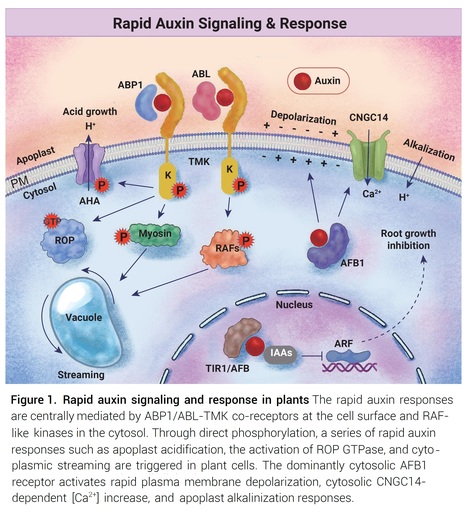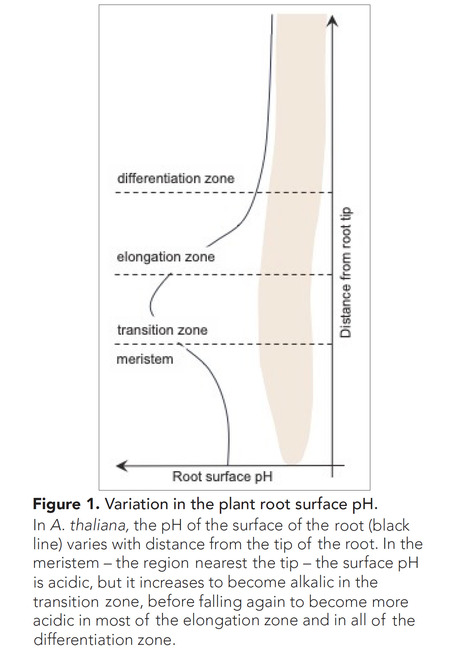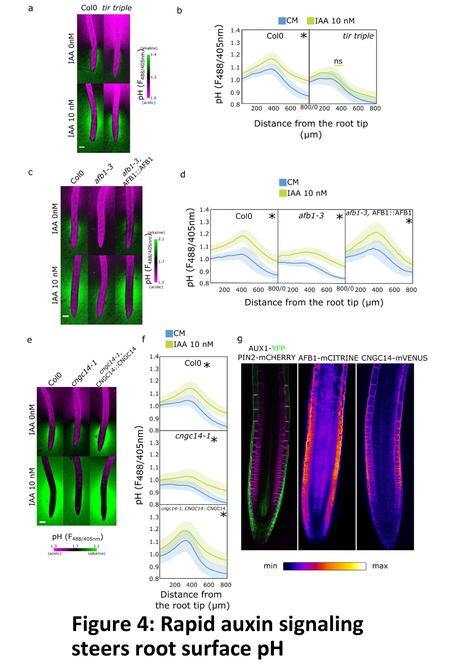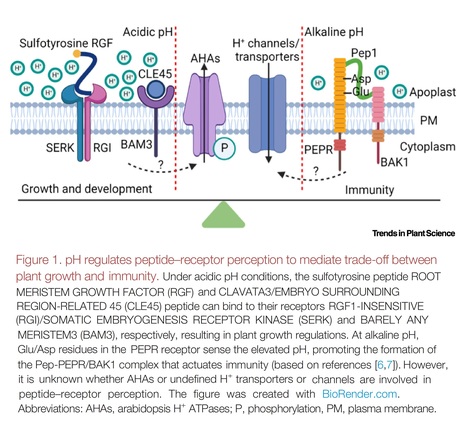 Your new post is loading...
 Your new post is loading...
Authors: Yewei Zhou, Chunyan Wang, Yongqiang Yu, Zhaojun Ding and Tongda Xu.
The Innovation Life (2024)
Abstract: "Rapid auxin responses in plants are crucial in initiating cellular changes. These responses are involved in processes such as plasma membrane depolarization, cytoplasmic streaming, apoplastic pH changes, calcium influx, etc. Recent studies illustrated how auxin triggers rapid changes in protein phosphorylation in different species through both the ABP-TMK auxin perception at the cell surface and a conserved RAF-like kinase-based mechanism. These works uncovered an ancient system for rapid responses to the auxin signaling molecule, shedding light on its profound impact on various cellular pathways and functions."
Authors: Seoyeon Cha, Wang Ki Min and Hak Soo Seo
Communications Biology (2024)
One-sentence summary: Arabidopsis E3 ubiquitin ligase CONSTITUTIVE PHOTOMORPHOGENIC 1 (COP1) suppresses the activity of plasma membrane H+-ATPase, thereby maintaining proper pH profiles of the guard cells and subsequent stomatal responses.
Abstract: "Plants rely on precise regulation of their stomatal pores to effectively carry out photosynthesis while managing water status. The Arabidopsis CONSTITUTIVE PHOTOMORPHOGENIC 1 (COP1), a critical light signaling repressor, is known to repress stomatal opening, but the exact cellular mechanisms remain unknown. Here, we show that COP1 regulates stomatal movement by controlling the pH levels in guard cells. cop1-4 mutants have larger stomatal apertures and disrupted pH dynamics within guard cells, characterized by increased vacuolar and cytosolic pH and reduced apoplastic pH, leading to abnormal stomatal responses. The altered pH profiles are attributed to the increased plasma membrane (PM) H+-ATPase activity of cop1-4 mutants. Moreover, cop1-4 mutants resist to growth defect caused by alkali stress posed on roots. Overall, our study highlights the crucial role of COP1 in maintaining pH homeostasis of guard cells by regulating PM H+-ATPase activity, and demonstrates how proton movement affects stomatal movement and plant growth."
Author: Elke Barbez.
One-sentence summary: The growth of a plant root relies on careful control of root surface pH.
eLife (2023)
Excerpts: "Cell elongation is a crucial process in the growth of plants, both above and below ground. An old theory from the 1970s postulates that plant cells can stretch when the pH of the apoplast, the space outside of the cell membrane, is low (Rayle and Cleland, 1970). A plant hormone, called auxin, mediates this process by activating proton pumps in the cell membrane, leading to an increase in the number of protons into the apoplast and thus a lower pH. This in turn, activates specific enzymes that help to loosen the cell wall and thus cell expansion (Rayle and Cleland, 1970). In the following decades, scientists remained intrigued to unravel the molecular mechanism behind this ‘acid growth theory’. Now, in eLife, Matyas Fendrych and colleagues – including Nelson Serre and Daša Wernerová as joint first authors – report new insights into the role of pH in the growth of plant roots in the model organism Arabidopsis thaliana (Serre et al., 2023)."
"The regulation of membrane-based proton pumps is central in the acid growth theory. Serre et al. show, however, that the auxin-induced alkaline root zonation was not caused by altered proton pump activity, suggesting a distinct mode of action."
"In summary, Serre et al. illustrate that the root surface of A. thaliana features distinct pH zones, particularly highlighting the alkaline region in the transition zone. By identifying three molecular players in this process – AUX1, AFB1 and CNGC14 – they provide further molecular evidence to support the role of fast auxin responses in the pH-dependent regulation of root growth."
Authors: Nelson B. C. Serre, Daša Wernerová, Pruthvi Vittal, Shiv Mani Dubey, Eva Medvecká, Adriana Jelínková, Jan Petrášek, Guido Grossmann and Matyáš Fendrych.
eLife (2023)
Abstract: "Plant roots navigate in the soil environment following the gravity vector. Cell divisions in the meristem and rapid cell growth in the elongation zone propel the root tips through the soil. Actively elongating cells acidify their apoplast to enable cell wall extension by the activity of plasma membrane AHA H+-ATPases. The phytohormone auxin, central regulator of gravitropic response and root development, inhibits root cell growth, likely by rising the pH of the apoplast. However, the role of auxin in the regulation of the apoplastic pH gradient along the root tip is unclear. Here we show, by using an improved method for visualization and quantification of root surface pH, that the Arabidopsis thaliana root surface pH shows distinct acidic and alkaline zones, which are not primarily determined by the activity of AHA H+-ATPases. Instead, the distinct domain of alkaline pH in the root transition zone is controlled by a rapid auxin response module, consisting of the AUX1 auxin influx carrier, the AFB1 auxin co-receptor and the CNCG14 calcium channel. We demonstrate that the rapid auxin response pathway is required for an efficient navigation of the root tip."
Authors: H. Nicholay Diaz-Ardila, Bojan Gujas, Qian Wang, Bernard Moret and Christian S. Hardtke.
Current Biology (2022)
Editor's view: This study by Diaz-Ardila et al. reports evidence that developing protophloem sieve elements in the Arabidopsis root tip self-organize their transition to differentiation by desensitizing themselves against inhibitory autocrine CLE45 peptide signaling through an apoplastic pH increase.
Highlights • Arabidopsis roots cannot sense CLE45 peptide on neutral to alkaline pH media • pH-dependent perception distinguishes CLE45 from its homologs CLE25 and CLE26 • CLE25 and CLE26 may mainly act paracrine, whereas CLE45 also acts autocrine • Protophloem sieve elements evade the CLE45 signal via apoplastic alkalinization
Abstract: "The plant vasculature delivers phloem sap to the growth apices of sink organs, the meristems, via the interconnected sieve elements of the protophloem.1,2,3 In the A. thaliana root meristem, the stem cells form two files of protophloem sieve elements (PPSEs), whose timely differentiation requires a set of positive genetic regulators. In corresponding loss-of-function mutants, signaling of secreted CLAVATA3/EMBRYO SURROUNDING REGION 45 (CLE45) peptide through the BARELY ANY MERISTEM 3 (BAM3) receptor is hyperactive and interferes with PPSE differentiation. This can be mimicked by an external CLE45 application to wild type. Because developing PPSEs express CLE45-BAM3 pathway components from early on until terminal differentiation, it remains unclear how they escape the autocrine inhibitory CLE45 signal. Here, we report that the wild type becomes insensitive to CLE45 treatment on neutral to alkaline pH media, as well as upon simultaneous treatment with a specific proton pump inhibitor at a standard pH of 5.7. We find that these observations can be explained by neither pH-dependent CLE45 uptake nor pH-dependent CLE45 charge. Moreover, pH-dependent perception specifically requires the CLE45 R4 residue and is not observed for the redundant PPSE-specific CLE25 and CLE26 peptides. Finally, pH-dependent CLE45 response in developing PPSEs as opposed to pH-independent response in neighboring cell files indicates that late-developing PPSEs can no longer sense CLE45. This is consistent with an apoplastic acidic to alkaline pH gradient we observed along developing PPSE cell files. In summary, we conclude that developing PPSEs self-organize their transition to differentiation by desensitizing themselves against autocrine CLE45 signaling through an apoplastic pH increase."
Authors: Nelson B.C. Serre, Daša Wernerová, Pruthvi Vittal, Shiv Mani Dubey, Eva Medvecká, Adriana Jelínková, Jan Petrášek, Guido Grossmann and Matyáš Fendrych.
bioRxiv (2022)
Abstract: "Plant roots navigate in the dark soil environments following the gravity vector. Cell divisions in the meristem and rapid cell growth in the elongation zone propel the root tips through the soil. Actively elongating cells acidify their apoplast to enable cell wall extension by the activity of plasma membrane AHA H+-ATPases. The phytohormone auxin, central regulator of gravitropic response and root development, inhibits root cell growth, likely by rising the pH of the apoplast. However, the role of auxin in the regulation of the apoplastic pH gradient along the root tip is unclear. Here we show, by using an improved method for visualization and quantification of root surface pH, that the Arabidopsis thaliana root surface pH shows distinct acidic and alkaline zones, which are not primarily determined by the activity of AHA H+-ATPases. Instead, the distinct domain of alkaline pH in the root transition zone is controlled by a rapid auxin response module, consisting of the AUX1 auxin influx carrier, the AFB1 auxin co-receptor and the CNCG14 calcium channel. We demonstrate that the rapid auxin response pathway is required for an efficient navigation of the root tip."
Authors: M. Arif Ashraf and Mohammad Aslam.
Molecular Plant (2022)
Excerpts: "Although it is known that the alkalization or acidification of apoplast is involved in cellular processes such as auxin-mediated cell elongation and pattern-triggered immunity, the molecular mechanism of extracellular pH perception remains unknown. This long-standing question was addressed recently by a research group led by Prof. Hongwei Guo from the Southern University of Science and Technology, China. The team (Liu et al., 2022) used molecular, biochemical, structural, and genetic analyses and revealed the indispensable role of peptide-receptor complexes in pH sensing in Arabidopsis root apical meristem (RAM) (Figure 1)."
"Liu et al. (2022) showed that pattern-triggered immunity signals cause a change in the acidic pH of the RAM, which is required for RAM cell division (Figure 1). They further showed that extracellular pH change in RAM apoplast is recognized by RGF1 and Pep1 peptide signaling."
"Moreover, they also established that posttranslational sulfation, which is essential for RGF bioactivity, is also indispensable for sensing pH and that sulphotyrosine in RGF1 acts as a pH sensor (Liu et al., 2022)."
|
Authors: Zhaoheng Lin, Pan Zhu, Liyang Gao, Xuanyi Chen, Meijing Li, Yuhe Wang, Junxian He, Ying Miao and Rui Miao.
Plant and Cell Physiology (2024)
Abstract: "The polyhydroxylated steroid phytohormone brassinosteroids (BRs) control many aspects of plant growth, development and responses to environmental changes. Plasma membrane (PM) H+-ATPase, the well-known PM proton pump, is a central regulator in plant physiology, which mediates not only plant growth and development, but also adaptation to stresses. Recent studies highlight that PM H+-ATPase is at least partly regulated via the BR signaling. Firstly, the BR cell surface receptor BRASSINOSTEROID-INSENSITIVE 1 (BRI1) and multiple key components of BR signaling directly or indirectly influence PM H+-ATPase activity. Secondly, the SMALL AUXIN UP RNA (SAUR) gene family physically interacts with BRI1 to enhance organ development of Arabidopsis by activating PM H+-ATPase. Thirdly, RNA-sequencing (RNA-seq) assays showed that the expression of some SAUR genes is upregulated under the light or sucrose conditions, which is related to the phosphorylation state of the penultimate residue of PM H+-ATPase in a time-course manner. In this review, we describe the structural and functional features of PM H+-ATPase, and summarize recent progress toward understanding the regulatory mechanism of PM H+-ATPase by BRs, and briefly introduce how PM H+-ATPase activity is modulated by its own biterminal regions and the post-translational modifications."
Authors: Shouguang Huang, Like Shen, M. Rob G. Roelfsema, Dirk Becker and Rainer Hedrich.
Science (2023)
Editor's view: Protons (H+) and calcium ions (Ca2+) are often shuttled across cellular membranes and act as signals. In plants, protons accumulate highly in the extracellular space, whereas Ca2+ stores can be found in the endoplasmic reticulum and other cellular compartments. H+ and Ca2+ concentrations in the cytoplasm are often closely correlated during signaling events. Huang et al. introduced a light-gated protist-derived ion channel into plant cells, allowing selective transport of H+ but not Ca2+. They found that induction of H+ transport into the cytoplasm led to subsequent Ca2+ release. This work establishes a causal relationship between intracellular pH and Ca2+ signaling in guard cells and offers a new tool for manipulating ion movement in other contexts.
Abstract: "Although there has been long-standing recognition that stimuli-induced cytosolic pH alterations coincide with changes in calcium ion (Ca2+) levels, the interdependence between protons (H+) and Ca2+ remains poorly understood. We addressed this topic using the light-gated channelrhodopsin HcKCR2 from the pseudofungus Hyphochytrium catenoides, which operates as a H+ conductive, Ca2+ impermeable ion channel on the plasma membrane of plant cells. Light activation of HcKCR2 in Arabidopsis guard cells evokes a transient cytoplasmic acidification that sparks Ca2+ release from the endoplasmic reticulum. A H+-induced cytosolic Ca2+ signal results in membrane depolarization through the activation of Ca2+-dependent SLAC1/SLAH3 anion channels, which enabled us to remotely control stomatal movement. Our study suggests a H+-induced Ca2+ release mechanism in plant cells and establishes HcKCR2 as a tool to dissect the molecular basis of plant intracellular pH and Ca2+ signaling."
Authors: Ajit Pal Singh, Rajni Kanwar and Ajay Kumar Pandey.
bioRxiv (2023)
Abstract: "Rhizospheric pH severely impacts plant growth and fitness through a numerous process and has emerged as a major determinant of crop productivity. Despite numerous attempts, the key questions related to plants response against rhizospheric pH remains largely elusive. The present study provides a mechanistic framework for rhizospheric pH-mediated root growth inhibition (RGI). Utilizing various genetic resources combined with pharmacological agents and high-resolution confocal microscopy, the study provides direct evidences for the involvement of jasmonates and auxin in rhizospheric pH-mediated RGI. We show that auxin maxima at root tip is tightly regulated by the rhizospheric pH. In contrast, jasmonates (JAs) abundance inversely correlates with rhizospheric pH. Further, JA mediated regulation of auxin maxima by GRETCHEN HAGEN 3 (GH3) family genes explains the pattern of RGI observed over the entire range of rhizospheric pH. Our findings revealed auxin as the key regulator of RGI during severe pH conditions, while JAs antagonistically regulate auxin response against rhizospheric pH."
Authors: Huibin Han, Alina Glazunova and Guodong Wang.
Trends in Plant Science (2023)
Abstract: "Diverse plant small peptides are perceived by their corresponding receptors to mediate local or long-distance intercellular communications in various developmental and adaptive programs; notably, the mechanisms of peptide–receptor perception remain largely unrevealed. Two reports (Liu et al.; Diaz-Ardila et al.) shed light on how pH regulates peptide–receptor perception."
Authors: Yu Liu, Chenglin Mu, Dongdong Du, Yi Yang, Lixin Li, Wei Xuan, Stefan Kircher, Klaus Palme, Xugang Li and Ruixi Li.
Frontiers in Plant Science (2022)
Abstract: "Root development and plasticity are assessed via diverse endogenous and environmental cues, including phytohormones, nutrition, and stress. In this study, we observed that roots in model plant Arabidopsis thaliana exhibited waving and oscillating phenotypes under normal conditions but lost this pattern when subjected to alkaline stress. We later showed that alkaline treatment disturbed the auxin gradient in roots and increased auxin signal in columella cells. We further demonstrated that the auxin efflux transporter PIN-FORMED 7 (PIN7) but not PIN3 was translocated to vacuole lumen under alkaline stress. This process is essential for root response to alkaline stress because the pin7 knockout mutants retained the root waving phenotype. Moreover, we provided evidence that the PIN7 vacuolar transport might not depend on the ARF-GEFs but required the proper function of an ESCRT subunit known as FYVE domain protein required for endosomal sorting 1 (FREE1). Induced silencing of FREE1 disrupted the vacuolar transport of PIN7 and reduced sensitivity to alkaline stress, further highlighting the importance of this cellular process. In conclusion, our work reveals a new role of PIN7 in regulating root morphology under alkaline stress."
Authors: Lei Zhang, Shizhong Zhang and Chengchao Zheng.
Trends in Plant Science (2023)
Abstract: "Transmembrane kinases (TMKs) and Feronia (FER) belong to the leucine-rich repeat receptor-like kinase family. Recent studies reveal that they coordinate plant growth and stress responses by regulating the balance between acidification and alkalization and crosstalk between auxin and abscisic acid, revealing a dynamic equilibrium in the regulation of the TMK-FER module in plants."
Authors: Li Liu, Wen Song, Shijia Huang, Kai Jiang, Yoshitaka Moriwaki, Yichuan Wang, Yongfan Men, Dan Zhang, Xing Wen, Zhifu Han, Jijie Chai and Hongwei Guo.
Cell (2022)
Editor's view: Cell-surface peptide-receptor complexes RGF1-RGFR and Pep1-PEPR function as pH sensors to regulate extracellular pH-mediated growth and immunity in root apical meristem region in Arabidopsis.
Highlights: • PTI alkalinizes the acidic extracellular pH in root meristem • Alkalinization impairs the acidic-dependent RGF1 signaling on root meristem growth • Alkalinization promotes the Pep1-PEPRs binding and enhances root immunity • Sulfotyrosine and Glu/Asp function as pH sensors on RGF1 and PEPRs, respectively
Abstract: "The extracellular pH is a vital regulator of various biological processes in plants. However, how plants perceive extracellular pH remains obscure. Here, we report that plant cell-surface peptide-receptor complexes can function as extracellular pH sensors. We found that pattern-triggered immunity (PTI) dramatically alkalinizes the acidic extracellular pH in root apical meristem (RAM) region, which is essential for root meristem growth factor 1 (RGF1)-mediated RAM growth. The extracellular alkalinization progressively inhibits the acidic-dependent interaction between RGF1 and its receptors (RGFRs) through the pH sensor sulfotyrosine. Conversely, extracellular alkalinization promotes the alkaline-dependent binding of plant elicitor peptides (Peps) to its receptors (PEPRs) through the pH sensor Glu/Asp, thereby promoting immunity. A domain swap between RGFR and PEPR switches the pH dependency of RAM growth. Thus, our results reveal a mechanism of extracellular pH sensing by plant peptide-receptor complexes and provide insights into the extracellular pH-mediated regulation of growth and immunity in the RAM."
|
 Your new post is loading...
Your new post is loading...
 Your new post is loading...
Your new post is loading...























